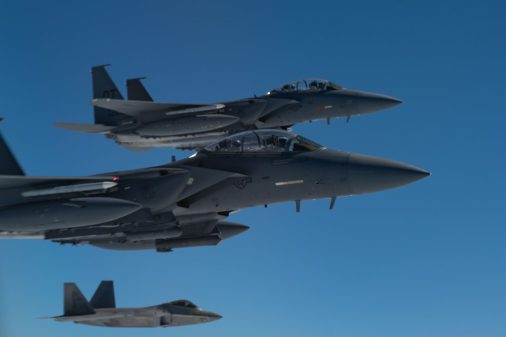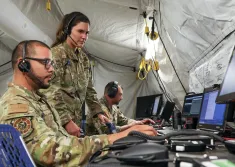16th Air Force looking to reevaluate how it generates requirements with Phoenix Initiative

NATIONAL HARBOR, Md. — The Air Force’s information warfare organization is looking to change how it develops requirements for new capabilities and concepts.
Created in 2019, 16th Air Force consolidated several commands and capabilities for intelligence, surveillance, reconnaissance, cyber, electronic warfare, information operations and weather, to set up an integrated information warfare command.
Given the breadth of its new missions and the consolidation of all these capabilities, the organization sought a different approach to generating new requirements and engaging with those outside the military through what it dubbed the Phoenix Initiative.
“What we want to be able to do is be more deliberate in our engagements with [industry, academic institutions and then government, science and technology, and research-and-development organizations], so that we can leverage that creativity, the innovative thoughts, to help harness those and then help us not only look at modern technology, but maybe help us to modernize from a process perspective within our structure,” Brian Cook, technical director of 16th Air Force, said in an interview Monday at AFA’s Air, Space and Cyber conference.
“Trying to be, again, more deliberate and looking at the holistic nature of our mission sets and making sure that our organizations understood there are a lot of things going on for research and development within industry and within faculty and staff at various academic institutions, that we should really be leveraging that thought leadership to help us mature and modernize moving forward. That was really it. Because we don’t think that we were really doing that very well early on,” he added.
Cook noted that in the spheres of offensive cyber and electromagnetic attack, the Air Force and U.S. military are the leaders. However, for the other areas under 16th Air Force’s purview, industry and academic organizations are the main drivers.
The Phoenix Initiative, which began around August 2023, was initially focused on 16th Air Force’s no-fail missions through Project Phoenix, a subset of the larger initiative.
Overall, the effort provides a venue for engagement with key non-government partners to include sessions on the sidelines of conferences. In fact, at the annual AFCEA Alamo ACE conference in November, Cook said officials will start to pull the veil back and have classified briefings that go beyond the typical mission briefs.
“We don’t want mission briefs. Don’t give us mission briefs. We can get your mission briefs outside every day. No big deal. We want to know the tough problems that you’re attempting to tackle, so that as we look at our research-and-development dollars, as we look at other opportunities to work for and with you, if we understand your tough problems and we’re able to do that. That’s a venue by which we’re attempting to do some of those things,” Cook said.
Overall, this is a more collaborative process with industry and academia than previously.
“We’re doing data calls that go out to our organizations and say, ‘What are the tough problems, what are the research interests, what are you trying to solve?’ Then taking those in and then trying to be able to explain and share those in a manner,” Cook said.
Some of the outcomes have been new concepts, such as industry highlighting different ways to employ existing capabilities, while the majority of the efforts have resulted in new contracts being let through commercial solutions openings.
The command has more leeway through that vehicle than others, allowing them to be able to release solicitations online and get organizations on contract quicker as a direct result of two-way collaboration with those outside government.
The first such effort was related to innovative ways to train intelligence, surveillance and reconnaissance airmen in cryptologic missions supporting special operations forces, while others were actually kicked up to the Air Force chief information officer level for them to consider.
Cook noted that officials are also trying to take more advantage of small business and technology transfer dollars, working closer with Air Force Research Laboratory and AFWERX.
“In that regard, it’s really allowed small businesses to start to provide proposals. And what they’ll do is they’ll pitch them to us and then we’ll look for operational sponsorship of [them], and then that goes in to compete and then AFRL, and then we’ll make those selections,” he said. “But what happened before is a lot of folks thought like you needed a hard ‘R’ requirement in the system, and then it was really about if you went forth with a phase — whatever it is within that process — then if it was successful, you were signing up to be the long-term sustainment of the capability. That is not what that is meant for. It’s looking for, how do we solve tough problems, are there innovative ways to do it? Then if you can provide the operational support to and it get selected, there’s opportunities then later to maybe bring it in to transfer over.”






